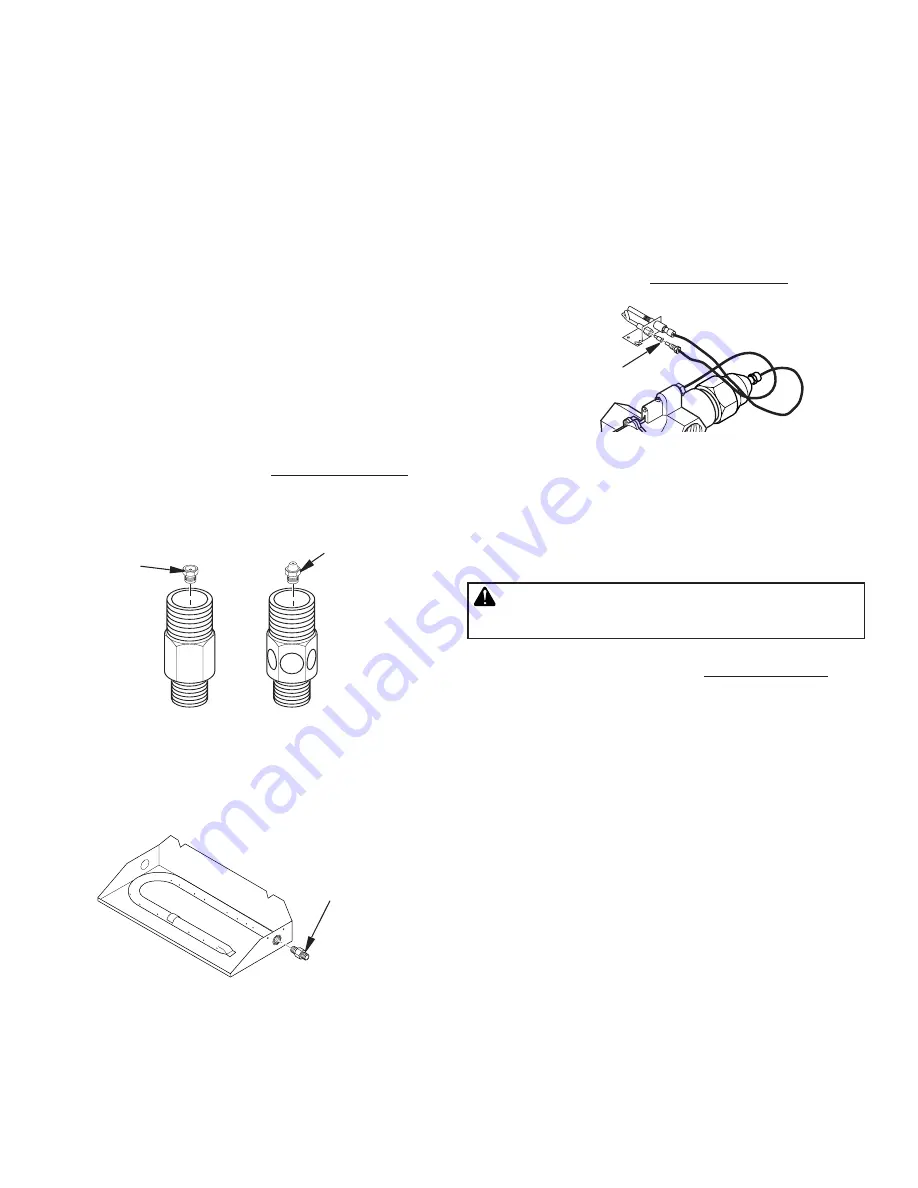
Comfortflame.US.com
900578-00_NC
10
Figure 12 - Burner Inlet Fittings with Injectors
Figure 13 - Remove Burner Inlet Fitting
NATURAL
GAS
FITTING
PROPANE/
LP GAS
FITTING
Injector
for Natural
Gas
Injector for
Propane/
LP Gas
Burner Inlet
Fitting for
Natural Gas
INSTALLATION
Continued
PROPANE/LP GAS CONVERSION
To convert to propane/LP gas, burner inlet fitting and pilot orifice must
be replaced. Propane/LP burner inlet fitting is supplied with orifice
installed for a 24" log set. If you have an 18" or 30" set, you must
change this orifice also. See Figure 1, page 4 for product identification.
Burner Inlet Fitting
1. Remove burner inlet fitting from burner pan assembly. DO NOT
remove orifice from this fitting. Propane/LP burner inlet fitting is
included in hardware kit (see Figure 12).
2. Be sure to use correct orifice for your appliance. The hardware kit
included with this appliance contains two orifices with a cone-like
shape. If you have an 18" set, orifice for burner inlet fitting is red;
for a 30" set, it is black. If you have a 24" log set, orifice is already
installed inside fitting.
3. For an 18" or 30" set, use a 10 mm socket or nut driver to remove
orifice from propane/LP burner inlet fitting. Choose the correct orifice
for your log set size and install in place of orifice you just removed.
4. Using thread sealant (resistant to the action of propane/LP gas)
on larger end of fitting, screw burner inlet fitting through hole and
into burner manifold (see Figure 13). Tighten using a wrench.
5 . Follow steps 1 through 12 under Natural Gas Installation, pages
8 and 9.
Changing Pilot Orifice
The pilot is provided with a natural gas orifice installed. For propane/
LP gas you must remove it and replace it with an propane/LP orifice.
The accessory hardware kit contains an propane/LP orifice with a red
stripe for converting pilot.
1. Gently loosen and remove pilot line connection from bracket (see
Figure 14).
2. Replace injector (see Figure 14) with propane/LP pilot injector
with red stripe.
3. Replace and tighten pilot line to bracket.
4. Continue with step 3 under Natural Gas Installation, page 8.
TESTING BURNER FOR LEAKS
1. Generously apply noncorrosive leak detection fluid to all connec-
tions.
WARNING: Never check for gas leaks with open
flame.
2. Light burner with shutoff valve no more than half open and holding
a match slightly in front of pan (see Lighting Instructions, page
12).
3. Inspect all connections for bubbles, raw gas odor, or flame from
any area other than burner (leaks). If leaks are detected, shut off
gas valve immediately. Tighten, or reassemble loose connection(s)
using pipe joint compound until burner system is leak free.
4. When burner is tested and leak free, observe individual tongues
of flame on burner.
Note:
Burner design includes more ports on the outside of the
bar. Make sure that all ports are clear and producing flame evenly
across burner. If any ports appear blocked, clear them by removing
burner manifold and reaming ports with a modified paper clip or
other suitable tool.
5. When finished testing, turn gas shutoff valve OFF to extinguish
all flames.
ADDING PAN MATERIAL
1. Open bag of ash bed material (vermiculite) and spread it evenly
across burner pan to top. You may overflow front and sides of
pan to cover entire pan and connecting hardware. Do not cover
GA9050A-1 (F0235) or GA9150A (F0237) valve.
2. Open glowing embers and evenly cover ash bed material (ver-
miculite) in burner pan.
Figure 14 - Installing Propane/LP Pilot Orifice
Pilot Injector











































